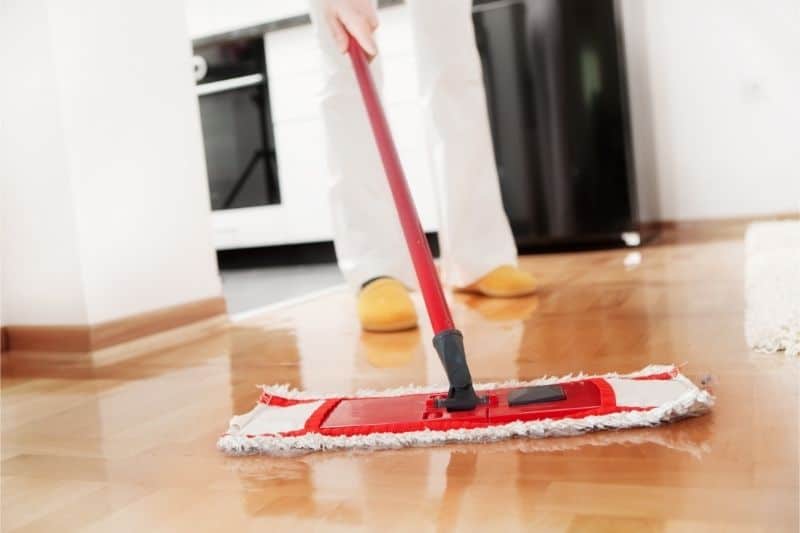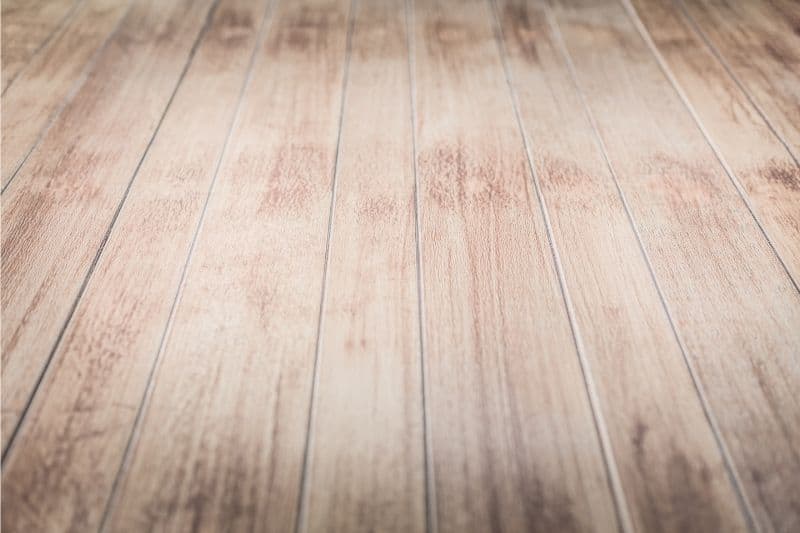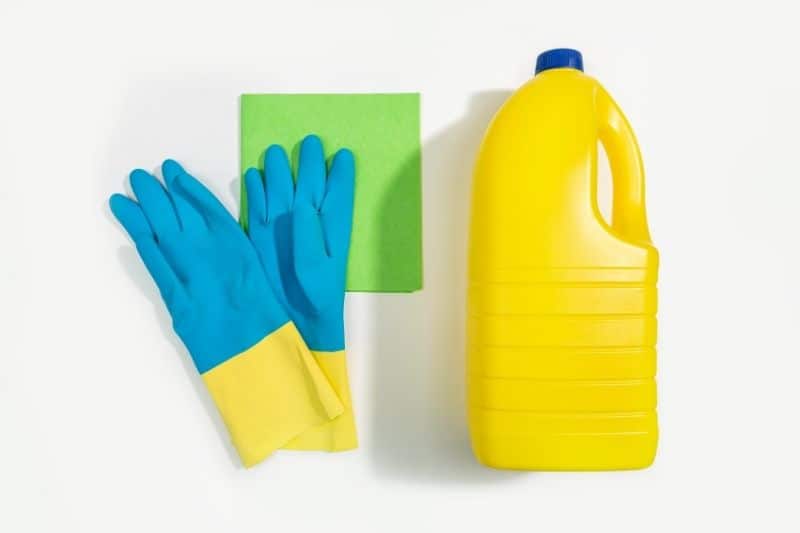Bleach is one of the most popular household cleaners on the market today. You can use it to clean counters, tubs, and toilets in your bathroom. But what about your hardwood floors? Can you clean hardwood floors with bleach? The answer is not quite so simple!

Can You Clean Hardwood Floors With Bleach?
It’s not safe to use bleach on your hardwood flooring because the strong chemicals in it can break down the finish and seep into some of its porous fibers. This will lead to discoloration and the weakening of your floorboards.
The number of bleach-free household cleaning products you can find today beats out their bleachy counterparts and there is no reason why you should put your hardwood floors at risk by using strong, hazardous chemicals.
However, as tricky as it may be, if you take the following precautions, it’s possible to clean your hardwood floor with bleach without damaging any of its surfaces.
What Happens When You Put Bleach on Hardwood Floors?
A significant problem with wood is that it’s a porous material, which means liquids can penetrate fairly deeply. Despite the fact that many hardwood floors are treated with a moisture-resistant sealant to prevent damage, there’s always some amount of protection lost when chemicals or acidic formulas come into contact with it.
Should you use bleach on your floors? I don’t recommend it – but before we get to why let me briefly talk about how bleach exposure could negatively affect your wood-grain surfaces in three ways: discoloration; damage to the coating protecting against liquid penetration; weakening structural integrity by causing splits in ancient knots found within natural woods such as oak and maple trees.
Discoloration of hardwood floors

Due to its corrosive nature, bleach can kill almost every type of bacteria, fungus, or virus. However, this same characteristic also has the potential to alter colors at the molecular level by altering their composition on contact with bleach.
Because of this, there are a number of alternatives to clean your hardwood floors that do not involve bleach.
Weakening of wood structure
Did you know that wood cells are held together by the plant-based equivalent of glue called lignans? Bleach can break those bonds and when it does, the risk heightens that your floors or stairs will ultimately lose structural integrity!
Splinters from broken wood fibers are one consequence; creaking floorboards is another possibility. Because of this, bleach should never be used on hardwood surfaces such as staircases where strength needs to be retained for safety reasons.
However, not all bleach is created equal. Let’s take a closer look at different kinds of bleach to gain a better understanding.
Types of Household Bleach
There are four general kinds of bleaches you can use to clean surfaces:
- Chlorine Bleach
- Non-Chlorine Bleach
- Two-Part Bleach
- Oxalic Acid
Chlorine Bleach
Chlorine bleach can often be found in home cleaning products, like Clorox. This chemical releases molecules formed from one chlorine and one oxygen atom, which help remove stubborn stains such as dye or coffee from floors.
Non-Chlorine Bleach
Non-chlorine bleach is a less toxic option than chlorine because it does not have as strong a disinfecting power nor do non-chlorine products change colors on surfaces. Non-chlorine bleach uses oxygen as its active ingredient and can be found in liquid and powdered form.
Two-Part Bleach
The two-part bleach is a mixture of sodium hydroxide and hydrogen peroxide. This type of bleach will whiten the surface, but it can also discolor any light-colored surfaces or woods nearby when sprayed on an exterior stain.
This type of bleach should only be used for outdoor applications where there are no other objects nearby that might get bleached from contact with the chemical solution if not handled properly.
Oxalic Acid
Oxalic acid is a crystalline acid that when mixed with water, releases oxygen radicals which will have an immediate reaction to the wood. This weaker bleach can be used for removing stains while being more environmentally friendly than other bleaches.
From this, we can conclude that oxalic acid is the best solution for disinfecting your wood floors. It’s so gentle that you can use it on any type of floor without worrying about damage, but also doesn’t leave behind a harsh chlorine smell or taste like other stronger solutions might have.
Caution When Using Bleach on Hardwood Floors

Although I don’t recommend that you do, one-time use or infrequent bleach application might be permissible in some situations! Let’s look at some examples:
What type of floor finish is used?
You may already know about the difference between surface finishes vs. penetrating ones, but did you also know that there are many types of each? Surface finishes like polyurethane can protect wood against bleach better than a penetrative finish like linseed oil because it sits on top of your hardwood floor to prevent liquids from seeping in deep down into its pores.
The downside is that caustic agents such as bleach still have an easy time getting through and infiltrating these types of products!
How old is the floor?
Older, more neglected wood floors tend to be weaker and will break down faster than freshly installed ones. This could have something to do with the natural settling of old wood floors as they wear over time, or even just neglect from those who used them in the past.
But it might also mean that your floor is probably at risk for damage if you don’t take care of it well – especially when bleach enters into play!
How concentrated is the bleach?
Bleach is a powerful disinfectant that can be dangerous if not diluted. The Centers for Disease Control recommends diluting it with water, five tablespoons per gallon to ensure the safety and effectiveness of the cleaner.
How to Neutralize Bleach on Wood Floor?
When you spill bleach on your hardwood floor, the first thing to do is act quickly. This will help prevent any damage from occurring and make it easier for a complete clean-up later. Here are some methods that can be used to neutralize a spilled or leaked bottle of bleaching agent:
- Soak up the excess liquid – blotting or scraping off as much spilled material as possible.
- Apply white vinegar (or other household acids like lemon juice or club soda), which will react chemically with the oxidized chlorine gas in order to form salt water harmless enough for contact surfaces.
- Use something absorbent such as bread crumbs (in case there is still an odor). Then, sweep the surface and vacuum.
Precautions: Be sure to avoid getting bleach on your skin as it can cause burns. If you do get bleach on your hands or clothes, wash them thoroughly with soap and water. Keep a jug of white vinegar in an easy-to-reach location for future spills too!
Safer Alternatives to Bleach for Cleaning Hardwood Floors
Using bleach has been the view for decades, now it’s time to broaden your horizons. With hardwood being a natural material, you can replace bleach with these safe alternatives that will also help rid yourself of harmful synthetic chemicals.
1. Ammonia-based cleaners (natural wood furniture with an ammonia scent typically only lasts 1-2 years)
2. Baking soda and vinegar (these two ingredients are safe for all types of surfaces).
It’s important to make sure that you’re using the right cleaning agent for your wood floor, and if you prefer DIY solutions avoid lemon juice or white vinegar. These products are acidic and may not be safe on porous surfaces like wood floors as they can break down finishes which could lead to water seeping in, damaging the surface of your hardwood floors over time.
Final Words
The best way to keep your floors looking their best is by taking preventative care steps like using protective mats at entrances and quick mopping between high traffic areas rather than waiting until there are major spills or worn down spots that need attention.

